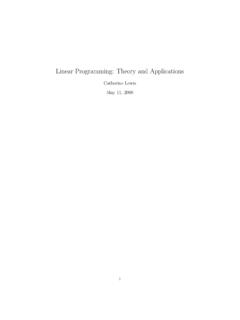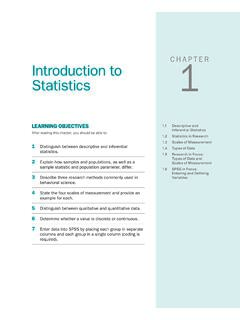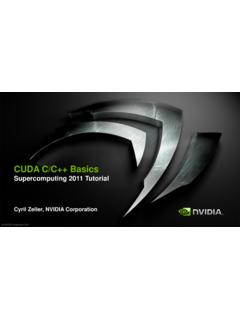Transcription of Entropy and Partial Differential Equations
1 Entropy and Partial Di erential Equations Lawrence C. Evans Department of Mathematics, UC Berkeley Inspiring Quotations A good many times I have been present at gatherings of people who, by the standards of traditional culture, are thought highly educated and who have with considerable gusto been expressing their incredulity at the illiteracy of scientists. Once or twice I have been provoked and have asked the company how many of them could describe the Second Law of Thermodynamics. The response was cold: it was also negative. Yet I was asking something which is about the scienti c equivalent of: Have you read a work of Shakespeare's? C. P. Snow, The Two Cultures and the Scienti c Revolution .. C. P. Snow relates that he occasionally became so provoked at literary colleagues who scorned the restricted reading habits of scientists that he would challenge them to explain the second law of thermodynamics.
2 The response was invariably a cold negative silence. The test was too hard. Even a scientist would be hard-pressed to explain Carnot engines and refrigerators, reversibility and irreversibility, energy dissipation and Entropy increase.. all in the span of a cocktail party conversation. E. E. Daub, Maxwell's demon . He began then, bewilderingly, to talk about something called Entropy .. She did gather that there were two distinct kinds of this Entropy . One having to do with heat engines, the other with communication.. Entropy is a gure of speech then .. a metaphor . T. Pynchon, The Crying of Lot 49. 1. CONTENTS. Introduction A. Overview B. Themes I. Entropy and equilibrium A. Thermal systems in equilibrium B. Examples 1. Simple uids 2. Other examples C. Physical interpretations of the model 1. Equilibrium 2. Positivity of temperature 3. Extensive and intensive parameters 4.
3 Concavity of S. 5. Convexity of E. 6. Entropy maximization, energy minimization D. Thermodynamic potentials 1. Review of Legendre transform 2. De nitions 3. Maxwell relations E. Capacities F. More examples 1. Ideal gas 2. Van der Waals uid II. Entropy and irreversibility A. A model material 1. De nitions 2. Energy and Entropy a. Working and heating b. First Law, existence of E. c. Carnot cycles d. Second Law e. Existence of S. 3. E ciency of cycles 4. Adding dissipation, Clausius inequality B. Some general theories 1. Entropy and e ciency 1. a. De nitions b. Existence of S. 2. Entropy , temperature and separating hyperplanes a. De nitions b. Second Law c. Hahn Banach Theorem d. Existence of S, T. III. Continuum thermodynamics A. Kinematics 1. De nitions 2. Physical quantities 3. Kinematic formulas 4. Deformation gradient B. Conservation laws, Clausius Duhem inequality C.
4 Constitutive relations 1. Fluids 2. Elastic materials D. Workless dissipation IV. Elliptic and parabolic Equations A. Entropy and elliptic Equations 1. De nitions 2. Estimates for equilibrium Entropy production a. A capacity estimate b. A pointwise bound 3. Harnack's inequality B. Entropy and parabolic Equations 1. De nitions 2. Evolution of Entropy a. Entropy increase b. Second derivatives in time c. A di erential form of Harnack's inequality 3. Clausius inequality a. Cycles b. Heating c. Almost reversible cycles V. Conservation laws and kinetic Equations A. Some physical PDE. 2. 1. Compressible Euler Equations a. Equations of state b. Conservation law form 2. Boltzmann's equation a. A model for dilute gases b. H-Theorem c. H and Entropy B. Single conservation law 1. Integral solutions 2. Entropy solutions 3. Condition E. 4. Kinetic formulation 5.
5 A hydrodynamical limit C. Systems of conservation laws 1. Entropy conditions 2. Compressible Euler Equations in one dimension a. Computing Entropy / Entropy ux pairs b. Kinetic formulation VI. Hamilton Jacobi and related Equations A. Viscosity solutions B. Hopf Lax formula C. A di usion limit 1. Formulation 2. Construction of di usion coe cients 3. Passing to limits VII. Entropy and uncertainty A. Maxwell's demon B. Maximum Entropy 1. A probabilistic model 2. Uncertainty 3. Maximizing uncertainty C. Statistical mechanics 1. Microcanonical distribution 2. Canonical distribution 3. Thermodynamics VIII. Probability and di erential Equations A. Continuous time Markov chains 3. 1. Generators and semigroups 2. Entropy production 3. Convergence to equilibrium B. Large deviations 1. Thermodynamic limits 2. Basic theory a. Rate functions b. Asymptotic evaluation of integrals C.
6 Cramer's Theorem D. Small noise in dynamical systems 1. Stochastic di erential Equations 2. Ito 's formula, elliptic PDE. 3. An exit problem a. Small noise asymptotics b. Perturbations against the ow Appendices: A. Units and constants B. Physical axioms References 4. INTRODUCTION. A. Overview This course surveys various uses of Entropy concepts in the study of PDE, both linear and nonlinear. We will begin in Chapters I III with a recounting of Entropy in physics, with particular emphasis on axiomatic approaches to Entropy as (i) characterizing equilibrium states (Chapter I), (ii) characterizing irreversibility for processes (Chapter II), and (iii) characterizing continuum thermodynamics (Chapter III). Later we will discuss probabilistic theories for Entropy as (iv) characterizing uncertainty (Chapter VII). I will, especially in Chapters II and III, follow the mathematical derivation of Entropy pro- vided by modern rational thermodynamics, thereby avoiding many customary physical ar- guments.
7 The main references here will be Callen [C], Owen [O], and Coleman Noll [C-N]. In Chapter IV I follow Day [D] by demonstrating for certain linear second-order elliptic and parabolic PDE that various estimates are analogues of Entropy concepts ( the Clausius inequality). I as well draw connections with Harnack inequalities. In Chapter V (conserva- tion laws) and Chapter VI (Hamilton Jacobi Equations ) I review the proper notions of weak solutions, illustrating that the inequalities inherent in the de nitions can be interpreted as irreversibility conditions. Chapter VII introduces the probabilistic interpretation of Entropy and Chapter VIII concerns the related theory of large deviations. Following Varadhan [V]. and Rezakhanlou [R], I will explain some connections with Entropy , and demonstrate various PDE applications. B. Themes In spite of the longish time spent in Chapters I III, VII reviewing physics, this is a mathematics course on Partial di erential Equations .
8 My main concern is PDE and how various notions involving Entropy have in uenced our understanding of PDE. As we will cover a lot of material from many sources, let me explicitly write out here some unifying themes: (i) the use of Entropy in deriving various physical PDE, (ii) the use of Entropy to characterize irreversibility in PDE evolving in time, and 5. (iii) the use of Entropy in providing variational principles. Another ongoing issue will be (iv) understanding the relationships between Entropy and convexity. I am as usual very grateful to F. Yeager for her quick and accurate typing of these notes. 6. CHAPTER 1: Entropy and equilibrium A. Thermal systems in equilibrium We start, following Callen [C] and Wightman [W], by introducing a simple mathematical structure, which we will later interpret as modeling equilibria of thermal systems: Notation.
9 We denote by (X0 , X1 , .. , Xm ) a typical point of Rm+1 , and hereafter write E = X0 .. A model for a thermal system in equilibrium Let us suppose we are given: (a) an open, convex subset of Rm+1 , and (b) a C 1 -function (1) S: R. such that .. (i) S is concave S. (2) (ii) E >0.. (iii) S is positively homogeneous of degree 1. We call the state space and S the Entropy of our system: (3) S = S(E, X1 , .. , Xm ). Here and afterwards we assume without further comment that S and other functions derived from S are evaluated only in open, convex regions where the various functions make sense. In particular, when we note that (2)(iii) means (4) S( E, X1 , .. , Xm ) = S(E, X1 , .. , Xm ) ( > 0), we automatically consider in (4) only those states for which both sides of (4) are de ned. Owing to (2)(ii), we can solve (3) for E as a C 1 function of (S, X1.)
10 , Xm ): (5) E = E(S, X1 , .. , Xm ). We call the function E the internal energy. De nitions. T = E. S. = temperature (6). Pk = Xk = k th generalized force (or pressure). E. 7. Lemma 1 (i) The function E is positively homogeneous of degree 1: (7) E( S, X1 , .. , Xm ) = E(S, X1 , .. , Xm ) ( > 0). (ii) The functions T, Pk (k = 1, .. ) are positively homogeneous of degree 0: . T ( S, X1 , .. , Xm ) = T (S, X1 , .. , Xm ). (8). Pk ( S, X1 , .. , Xm ) = Pk (S, X1 , .. , Xm ) ( > 0). We will later interpret (2), (7) physically as saying the S, E are extensive parameters and we say also that X1 , .. , Xn are extensive. By contrast (8) says T, Pk are intensive parameters . Proof. 1. W = E(S(W, X1 , .. , Xm ), X1 , .. , Xm ) for all W, X1 , .. , Xm . Thus W = E(S( W, X1 , .. , Xm ), X1 , .. , Xm ). = E( S(W, X1 , .. , Xm ), X1 , .. , Xm ) by (4). Write S = S(W, X1.
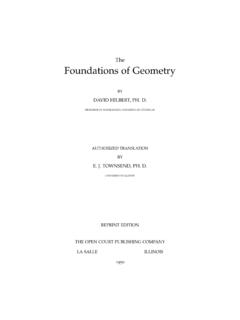
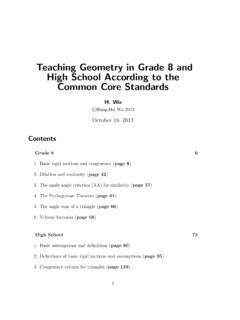





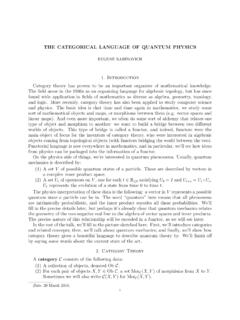



![arXiv:2005.14165v4 [cs.CL] 22 Jul 2020](/cache/preview/4/5/0/8/0/d/2/2/thumb-45080d222facc6d76a53aa8ccbd3eddb.jpg)
